
In the wake of Earth Day, green-bordered magazines and quivering news reports of Global Warming, it could be easy to dismiss the occasion as an over commercialization on par with Christmas. But one only need to discover the plastic mass twice the size of Texas in the middle of the Pacific Ocean, for example, or to learn there are 43,000 pieces of plastic per square mile of ocean to send chills down the spine of even, perhaps, Rush Limbaugh, to know that 'tis not at all overdone. If anything it should be Earth Month, no Earth Year--and every year at that.
Hence continue to I celebrate artists who keep our havoc in plain sight by making tangible visuals from the non-biodegradable trash we heap onto our oceans and on our planet. Australian artist John Dahlsen is one such artist who has taken it upon himself to use items discarded on beaches to create art. Dahlsen scours Australian beaches for found materials to recycle and transform into environmental art. Below behold "totems" of flip-flops conveniently organized by warm and cool colors for our instant viewing horror/pleasure.
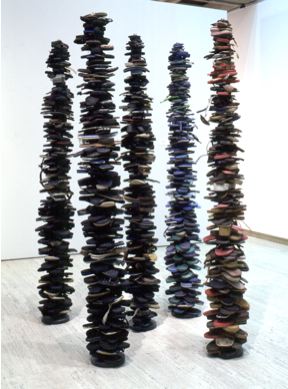 John Dahlsen, "Thong Totems", Stainless steel, steel and found objects (rubber thongs), 2.2m (h) x 30cm (w) each (5 in total), 2000.
John Dahlsen, "Thong Totems", Stainless steel, steel and found objects (rubber thongs), 2.2m (h) x 30cm (w) each (5 in total), 2000.
Besides the thongs, Dahlsen has made a series of totems out of plastic soda bottles, buoys, foam, and driftwood. In another series, Dahlsen uses found plastic bags (now banned in certain cities such as San Francisco), and layers them to create seascapes that resemble sand-sculptures.
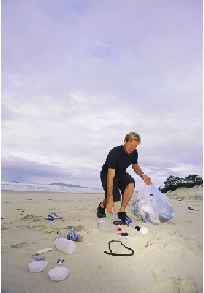
Kimberly Brooks: Was there a defining moment that pointed you towards your work?
John Dahlsen: I was collecting driftwood, on a remote Victorian Coastline, with the intention of making furniture and stumbled upon vast amounts of plastic ocean debris. This whole new palette of color and shape revealing itself to me immediately affected me; I had never seen such hues and forms before which enabled me to make new environmental art. Since then - for approximately 10 years, I scoured Australian beaches for found objects, much of which I found as washed up 'ocean litter'. I have since discovered this is a worldwide phenomenon, affecting beaches on a global level.
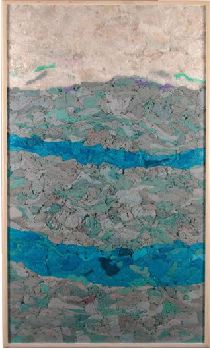 John Dahlsen, "Blue River", Recycled plastic bags behind perspex, 2 m (h) x 1.2 m (w), 2003. Wynne Prize Finalist, NSW Art Gallery
John Dahlsen, "Blue River", Recycled plastic bags behind perspex, 2 m (h) x 1.2 m (w), 2003. Wynne Prize Finalist, NSW Art Gallery
KB: There has been much ado in the states lately about banning plastic bags; cities are banning them and we're learning to love canvas in their place. How have plastic bags factored into your environmental art?
JD: I actually started using recycled plastic bags as my primary medium in 2003. These works signaled a slight departure from my more recognizable assemblage works, in which I used plastics and other detritus collected from the Eastern seaboard. I am with this work, apart from wishing to express obvious environmental messages, particularly interested in the brilliance of the colors and textures available to me in working with this medium. I am constantly surprised to see the variations in these plastics, very much like how I am intrigued by the beach found objects I have collected over the years. I imagine these plastic bags, which mostly have a lifespan of many years, are in fact on the verge of extinction, as it is only a matter of time before governments impose such strict deterrents to people using them that they become a thing of the past. A fitting end to what has become such a scourge to our environment on a worldwide scale.
The Irish Government imposed a 10 cent levy on the use of these bags some years ago and saw the consumption of this product decrease by approximately 90% within a year, a reduction of many billions of plastic bags per year!
Once again, I am able as a contemporary visual artist, to use these recycled materials, to create artworks which I hope, express a certain beauty as well as containing their own unique environmental messages.
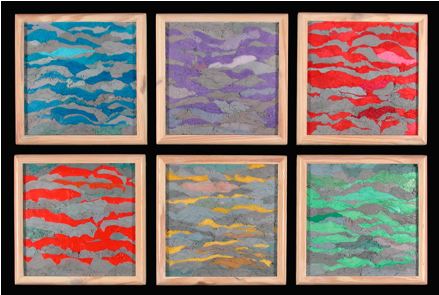 John Dahlsen, "Zebra Plastics" (6 Panels), Recycled plastic bags behind perspex, 44 cm (h) x 44 cm (w) each, 2003.
John Dahlsen, "Zebra Plastics" (6 Panels), Recycled plastic bags behind perspex, 44 cm (h) x 44 cm (w) each, 2003.
KB: You (and your studio) must have been overwhelmed with found materials when you return from your beach trips. Once you had collected all of this detritus, how did you begin constructing and creating your various works?
JD: I brought these plastics back to my studio to sift, sort, and color-code for my assemblages, sculptures and installations. As I worked with these objects, I became even more fascinated by the way they had been modified and weathered by the ocean and nature's elements. My challenge as an artist was to take these found objects, which might on first meeting have no apparent dialogue, and to work with them until they spoke and told their story, which included those underlying environmental messages inherent in the use of this kind of medium.
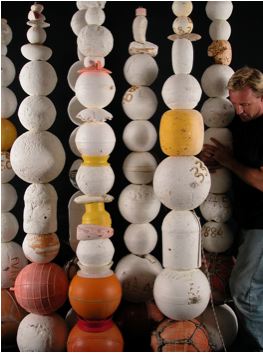 John Dahlsen, "Buoy Totems", found plastic objects and stainless steel, 2.2 m x 40 cm base ea.
John Dahlsen, "Buoy Totems", found plastic objects and stainless steel, 2.2 m x 40 cm base ea.
KB: Your works are more complex than some other so-called environmental art. While it certainly has an underlying message of conservation, it also overpowers its viewers in scale. Your totems stand taller than the viewers and complicate the way we, as consumers, both glorify physical goods and then take them for granted by deeming them garbage.
JD: I see that by making this art, it is a way of sharing my messages for the need to care for our environment with a broad audience. I feel that even if just a fraction of the viewing audience were to experience a shift in their awareness and consciousness about the environment and art, through being exposed to this artwork then it would be worth it. This stems from the fact that I believe presently humanity is at a critical point in time, with our planet currently existing in a fragile ecological state, with global warming hastening unheard of changes, all amplifying the fact that we need all the help we can get.
This is my way of making a difference, and at the same time I'm sharing a positive message about beauty that can be gained from the aesthetic experience of appreciating art, as well as giving examples of how we can recycle and reuse in creative ways. These artworks exemplify my commitment as an artist to express contemporary social and environmental concerns. By presenting this art, to the public it will hopefully have people thinking about the deeper meaning of the work, in particular the environmental issues we currently face.
I hope these works will act as a constant reminder to people about awareness. I would like them to find enjoyment the work on many levels and find themselves becoming identified in various ways with each of the artworks they see. I also look forward to the possible discussion that these works may generate as a result. I say these things as being possibilities, bearing in mind as well that comments are regularly made to me about people's consciousness, while walking the beach, being awakened after seeing my found plastic object artworks, similarly with seeing my recycled plastic bag series, people have marveled at the creative way I am presenting the recycling theme in an aesthetic way. With this in mind, I leave the final alchemy of the work to the viewer with the possibility they may experience deep perceptual shifts and have a positive aesthetic experience as they interact with my art.

John Dahlsen is based in Byron Bay Australia. He studied in Melbourne at the Victorian College of the Arts and at the Melbourne College of Advanced Education. He won numerous awards including Australia's prestigious Wynne Prize, Geraldton Art Prize and the mixed media/new media award at the 2003 Florence Biennial. For 25 years he has had regular solo and group exhibitions in Australia, in both commercial and regional galleries and internationally, in USA and Europe, where he is also represented in major public and private collections in Australia, New York, Milan, Belgium, and Amsterdam. He had a major solo exhibition of his work at the Tweed Regional Art Gallery in February 2005 and his sculpture "Pink Shard" made from fused toughened glass panels with a plastic interlayer bearing image won him another award, at the 2005 Thursday Plantation East Coast Sculpture Show. During June 2006, he had a solo exhibition at parliament house in Sydney. His most recent exhibition was in New York from November-December of 2007, in "Ecological Integrity / On The Brink". www.johndahlsen.com
--
First Person Artist is a weekly column by artist Kimberly Brooks in which she provides commentary on the creative process and showcases artists' work from around the world. Come back every Saturday for more Kimberly Brooks. You can view more interviews and essays at www.firstpersonartist.com
